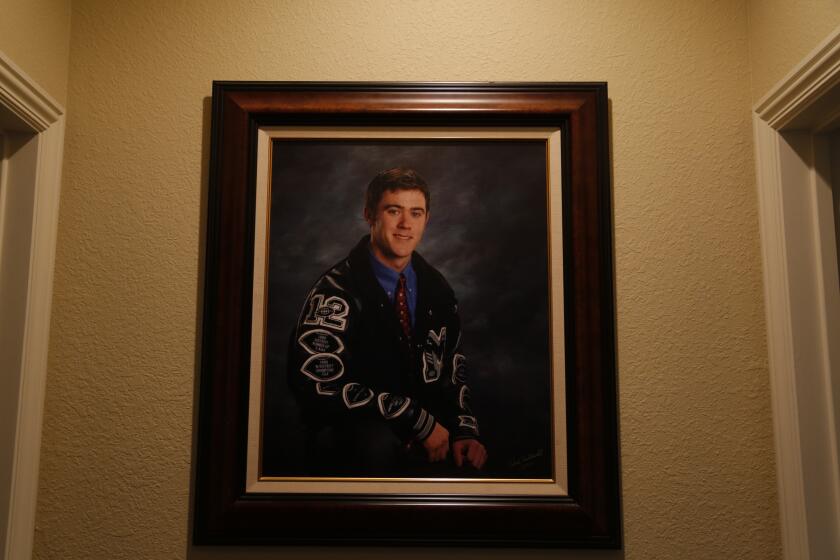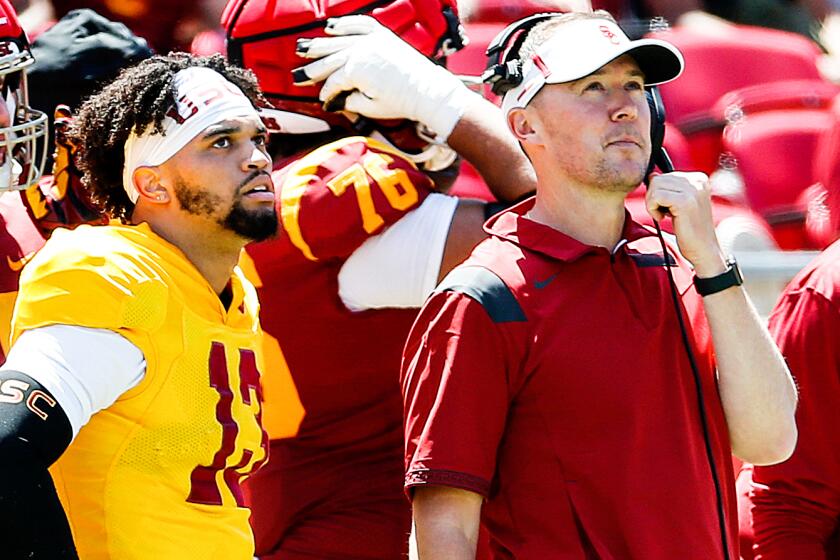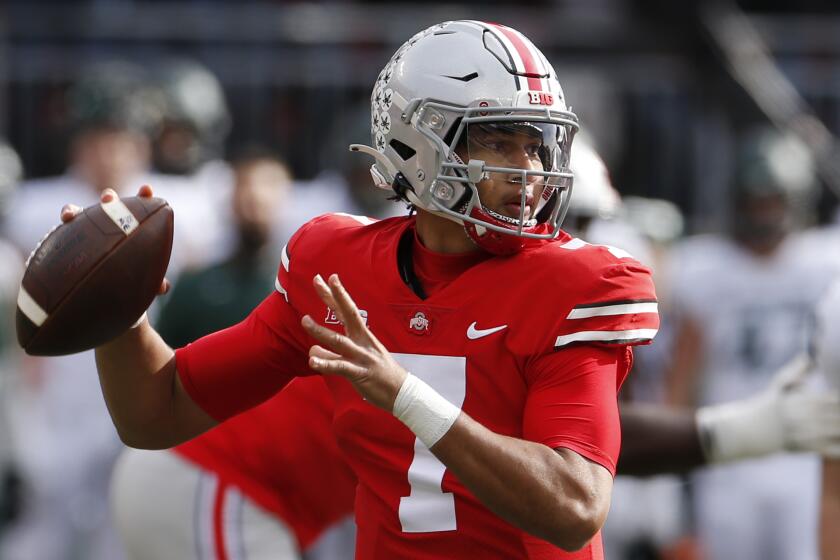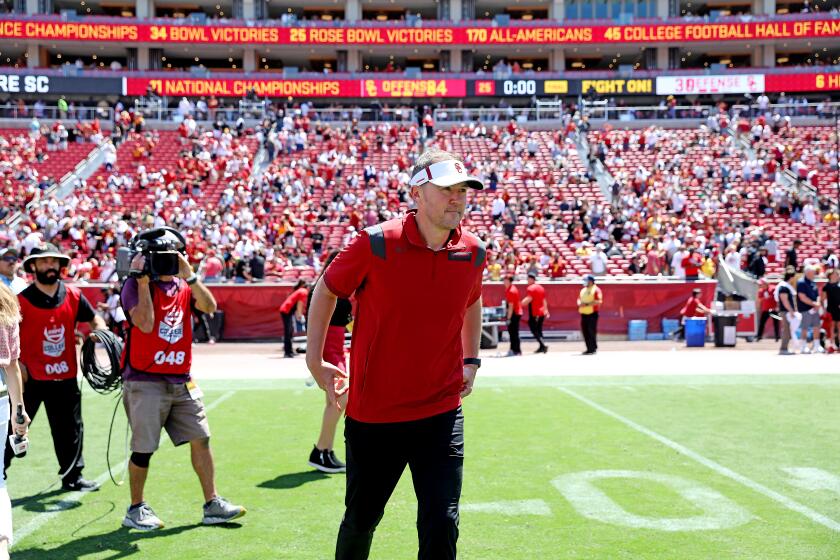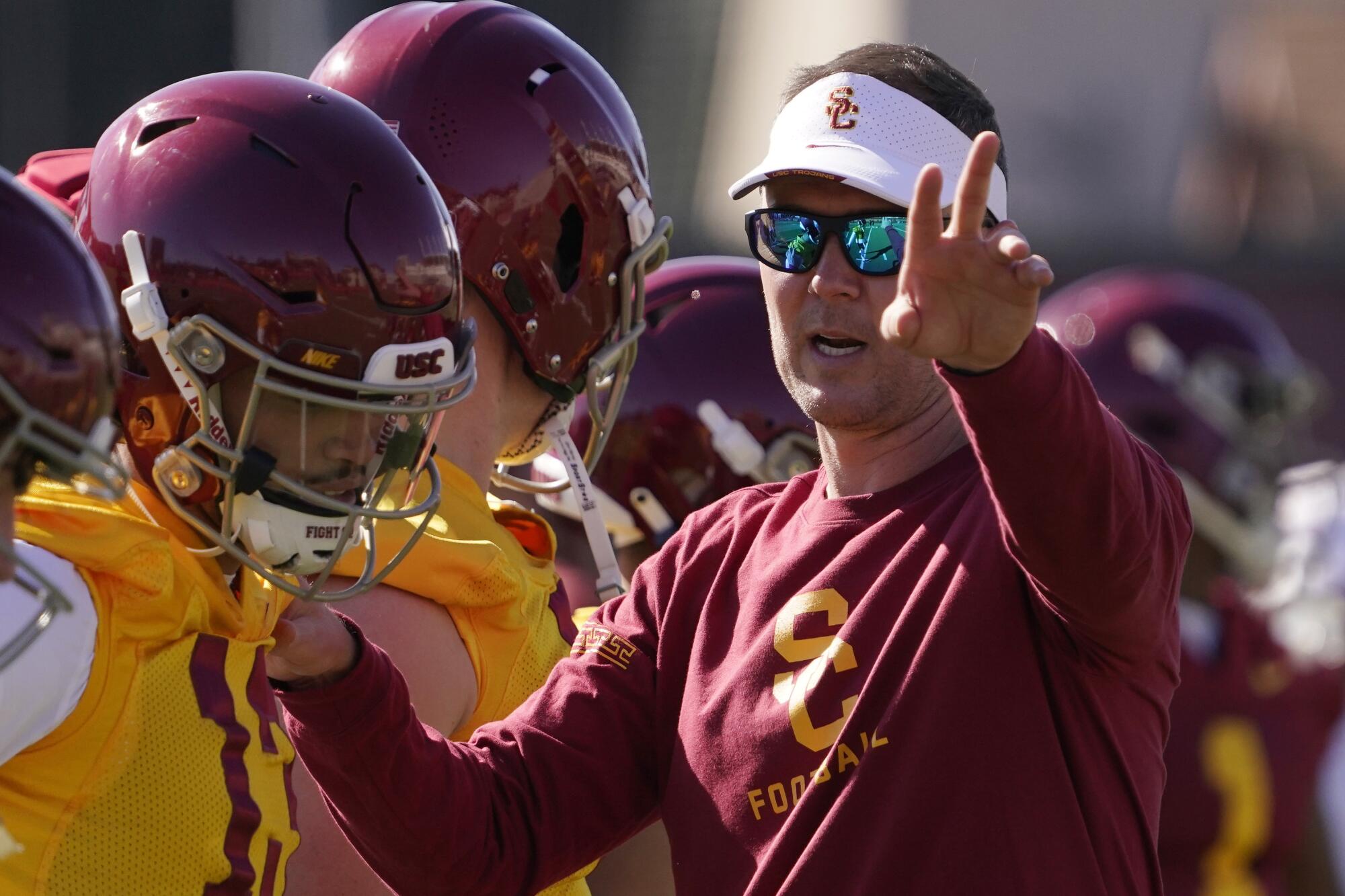
- Share via
The ideas that would one day inspire a football revolution had been rattling around in Hal Mumme’s head for a few years before he finally had the chance to use them. It was 1986, and Mumme had just lost his job as Texas El Paso’s offensive coordinator. With nowhere to turn at the college level, Mumme retreated to the ranks of Texas high school football, where he inherited a struggling program with just a handful of wins during the previous decade.
Out of that desperation, the Air Raid’s roots first took hold in the central Texas soil, where three-yards-and-a-cloud-of-dust was long the offensive doctrine of choice. Mumme didn’t have that luxury at Copperas Cove High. The school’s best athletes weren’t even trying out for the football team.
“I needed an edge,” Mumme recalled, “or else this wasn’t going to work.”
So he strung wild ideas together into a fledgling philosophy, drawing primarily on intel he gathered years before on long car trips to Provo, Utah. Brigham Young coach LaVell Edwards and his staff had often welcomed the UTEP coordinator to pick their brains. During those sessions, Mumme grew enamored with Edwards’ offense, which soared to the 1984 national title with a high-flying pass attack that spread three or four receivers across the field.
Such radical innovation was out of the question at UTEP, where head coach Bill Yung preferred the classic I-Formation. But at Copperas Cove, Mumme was in control. He told prospective players he’d employ a similar wide-open approach to BYU, but “on steroids.” They might throw the ball 75% of the time. He borrowed option route concepts from Mouse Davis and June Jones, two pioneers of the run-and-shoot, and game-planning and play-calling principles from Bill Walsh, the San Francisco 49ers coach and godfather of the West Coast offense.
Lincoln Riley’s path to USC was forged in Muleshoe, Texas, where the locals say Riley could’ve been anything he wanted — but puzzle ‘Why L.A.?’
Three years later, when Mumme hired Mike Leach to be his offensive line coach, the pair of raconteur coaches set out to push the philosophy further as they climbed the rungs of college football, upsetting the stuffy football establishment at every stop from Iowa Wesleyan to Valdosta State to Kentucky.
The result, during years of offensive exploration, was less a rigid playbook than an ever-evolving philosophy, a blank canvas meant to stretch the bounds of a coach’s imagination as much as it stretched the field.
By now, nearly four decades since Mumme’s offense first debuted at Copperas Cove, the Air Raid has been stretched in every discernible direction. Coaches from coast to coast, across all levels of football, have put their spin on the system, adding new layers or stripping them away, implanting their own concepts atop Mumme’s original open-source philosophy.
The group includes USC coach Lincoln Riley, whose ever-evolving offense has made him the new face of the Air Raid in college football.
That, of course, was entirely the point. Adaptation, Mumme says, was central to the system’s foundation. “It was meant to allow people to put their own personalities, their own tweaks into it,” Mumme said. . In that way, the Air Raid remains as much about the moxie of its coach as anything else, rewarding those who refuse the instinct to skate along with the status quo.
As a student assistant under Leach, Riley learned how to think like a coach.
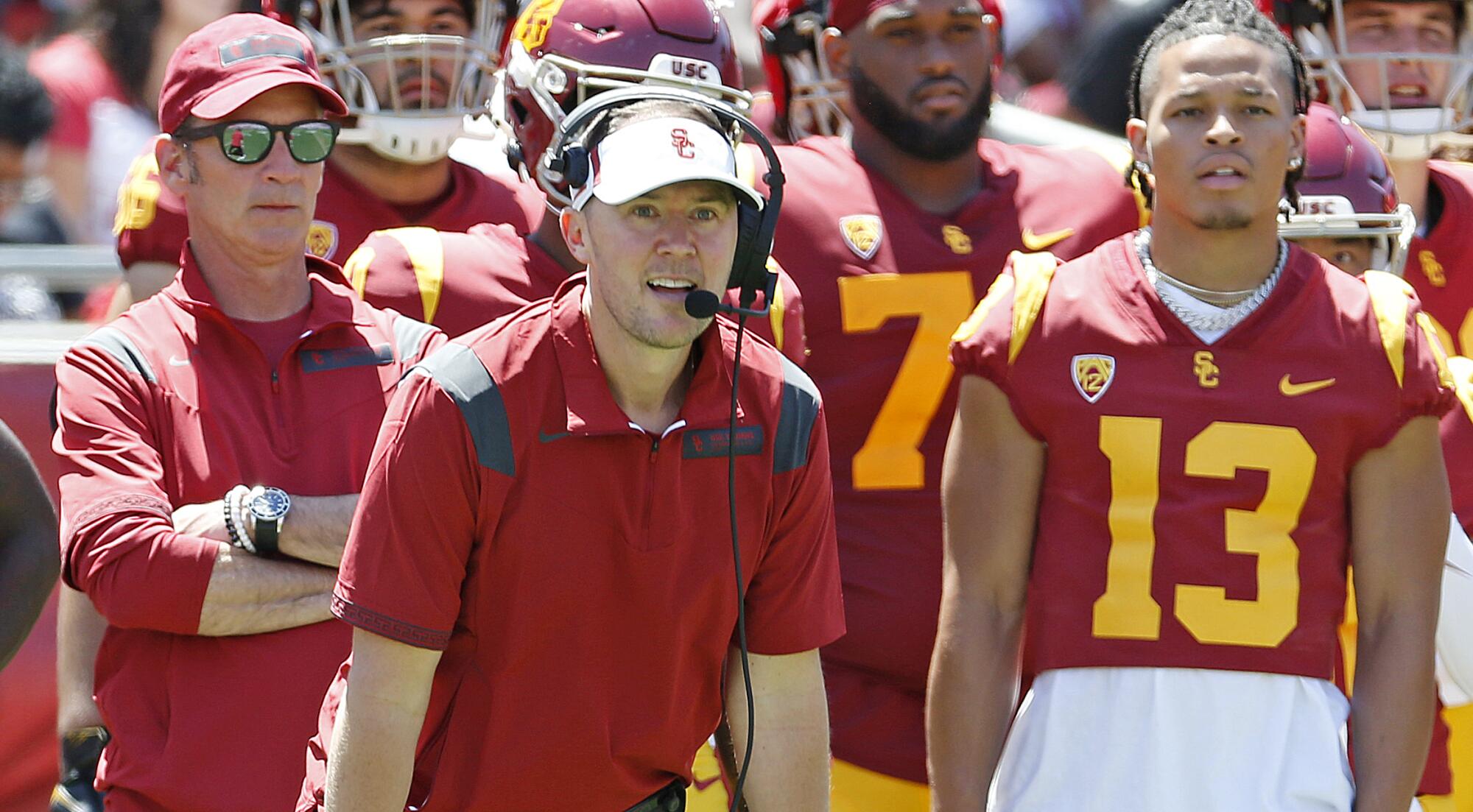
The Air Raid’s pliable nature was particularly suited to Riley, whose indoctrination first began two decades ago and six hours up the road from Copperas Cove in Lubbock. Since setting off on his own at East Carolina, his version of the Air Raid has taken every offense he’s ever installed to new heights.
“Lincoln has made all these tweaks, at every step of his career,” Mumme said. “He really does a great job of taking advantage of a skilled athlete and putting them in position to have an explosive play. That’s what I’ve always enjoyed watching with him. But when I watch, I’m still recognizing Y Cross and Mesh and stuff like that. He’s added to it, so he can best put those elite talent guys in places to succeed.”
During the seven years Riley led Oklahoma’s offense, the Sooners never finished worse than eighth nationally in scoring. At East Carolina, where he spent the five seasons before moving to Oklahoma, the Pirates finished in the top 25 in scoring three times — the best stretch, by far, in school history.
The expectation — in L.A., at least — is that he’ll bring an equally explosive attack to USC, where the latest iteration of his offense will finally debut Saturday.
If his education in the Air Raid is any indication, this version will look a bit different than any that came before it. But to understand where Riley might take the Trojans’ offense, it’s best to start with the philosophies that inspired it.
Designed to stretch the field vertically, opening up space either underneath, over the middle of the field, or deep, four verts isn’t just your favorite Hail Mary play call on Madden. It seeks to isolate receivers in 1-on-1 coverage, and with the likes of Jordan Addison or Mario Williams at USC, it can be lethal against man coverage. Especially if a deep safety is caught snoozing. Like most other concepts in the Air Raid, it has several variations, allowing for receivers to take advantage of space wherever they might find it.
Riley was not exactly an elite talent when he arrived at Texas Tech in 2002. A dislocated shoulder suffered during his senior season at Muleshoe High sapped most of the strength from his arm, forcing him to adjust his throwing motion to more of a looping sidearm release.
He could’ve signed with smaller local schools like West Texas A&M or a faraway Ivy like Dartmouth. But something about the offense Mike Leach was running up the road at Texas Tech spoke to him. While others in Lubbock were complaining about Leach’s pass-heavy approach, Riley was intrigued by its indifference to the game’s established mores. He was determined to learn the offense from the man himself. So he walked on, joining a room of eight other quarterbacks at Texas Tech.
His education would be far more hands-on than anyone planned. In Riley, Leach saw a critical thinker who asked the right questions. Plus he was picking up the offense faster than anyone else.
What Leach didn’t see was a capable college passer.
USC coach Lincoln Riley says he’s “taken the reins off” Caleb Williams, and the quarterback wants to prove he can be “Coach Riley Part 2 on the field.”
Riley was likely to be cut ahead of the 2003 season, so Leach asked the 19-year-old to join his coaching staff as a student assistant. During the next three seasons, he was Leach’s “right-hand guy,” doing whatever the coach asked and soaking in whatever he could. During those long hours alone with Leach, many of Riley’s philosophies about football and coaching were formed.
“He thought independently, and he was just very good at picking things up,” Leach said. “He was always anxious to learn. One of his most important qualities was that he never thought he had it all figured out.”
This was essential to Mumme‘s and Leach’s ideology. Both were constantly searching for ways to better their system or exploit some new edge.
“We would jump in my beat-up Ford Taurus and drive just about anywhere in America to chase an idea,” Mumme said.
Leach recalled once driving from Mount Pleasant, Iowa, to Green Bay Packers practice just to pick coach Lindy Infante’s brain about a specific route concept. Another strategic sojourn led them to Chicago Bears practice to see about beating the 46 defense.
You don’t see every offense utilizing an H-back, but with Lincoln Riley, it’s a puzzle piece position that unlocks a lot of the best wrinkles in his offense. In this play, the H-back appears to be blocking in the backfield, as the quarterback fakes a handoff and the weakside guard pulls. But then the H-back emerges in the seam, where the opposing linebackers have hopefully collapsed on the play-fake.
During one particularly fruitful trip to Florida, Leach and Mumme spent an afternoon with Don Matthews, a longtime CFL coach who was moonlighting as a spring league coach in Orlando. Mumme asked Matthews about his best drill. He told the two young coaches to wait until the end of practice, when they ran their two-minute offense.
“I’d never seen it this efficient and with everyone involved like they did it,” Mumme recalled. “I looked at Mike and said, ‘There’s our edge right there. Except we’re not going to do it in the last two minutes, we’re gonna do it all the time.’”
Soon enough, the Air Raid coaches were experimenting with their own version of that no-huddle, up-tempo approach.
When he hired Riley, Leach could see he was afflicted with a similar sense of curiosity. He didn’t simply accept things that Leach or other staff members taught him. He asked why. Before long, he became a sounding board for the coach to bounce off ideas.
After a couple of years on the job, Riley started offering his ideas in the staff room, which included future head coaches Dana Holgorsen, Sonny Dykes and Ruffin McNeill.
Thinking back on those meetings, Riley laughs. “There were some times early on in my career where I probably was too aggressive with that,” he said.
But Leach encouraged all of his assistants to challenge ideas or offer contrary opinions. He came to trust what his young assistant had to say. Riley joined Leach’s staff full-time in 2006, then was promoted to inside receivers coach the next season.
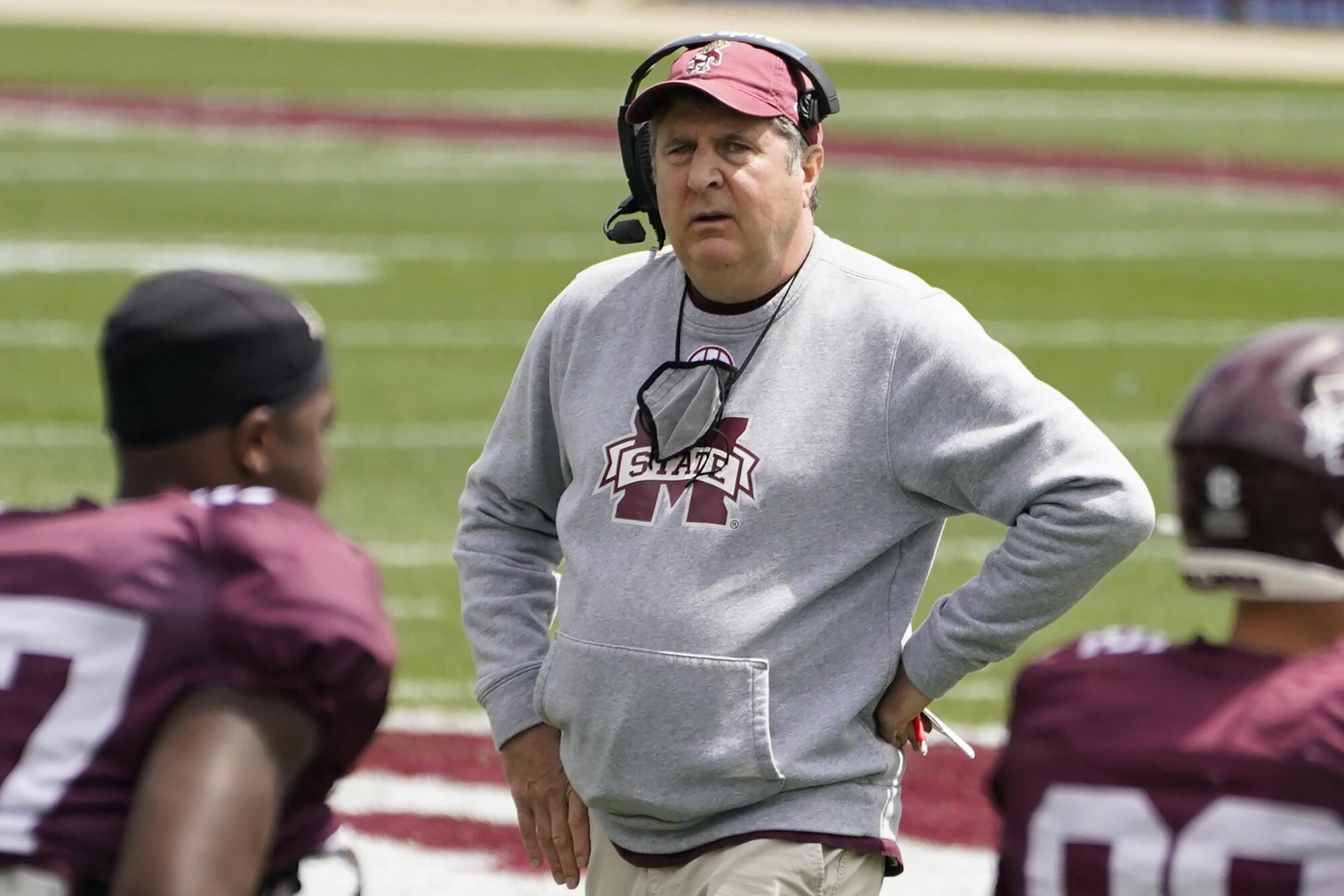
“Ninety-five percent of the evolution of this offense has come from guys in that staff room, constantly talking about it, thinking about it. You go to bed thinking about it. You dream about it.”
— Lincoln Riley
“I was always impressed that Lincoln wasn’t shy about sharing his thoughts, even though there were older, more experienced coaches in there,” Leach said. “If you do the same thing everyone else is doing, that’s all you are — everybody else.”
That lesson would shape the way Riley thinks about football.
While assembling his staff at USC, Riley said he sought independent thinkers who weren’t afraid to push boundaries.
“Ninety-five percent of the evolution of this offense has come from guys in that staff room, constantly talking about it, thinking about it,” Riley said. “You go to bed thinking about it. You dream about it. You wake up thinking about it. It continues to evolve. Defenses change, then offenses change and it’s a constant cat-and-mouse game. It’s fun. It consumes you.”
When Riley was finally handed the reins of an offense, he made his own adjustments to the philosophy he’d spent years learning under Leach. One of those changes would set him apart from previous purveyors of the Air Raid.
“A belief in a run game needed to be a part of it, in my opinion,” Riley said. “Everyone has different spins and different thoughts on that, but I believe that at some point, if you want to win big, you have to be able to run the ball and run the ball at a high level.”
In its simplest form, mesh involves two receivers running crossing patterns toward each other from opposite sides of the field. It’s intended to create traffic in the middle of the field, allowing for receivers to break loose of their defenders. But Riley often takes mesh to another level by adding more in- or out-breaking routes at different depths.
His first chance to call the shots came unexpectedly. Leach was fired in late December 2009 amid allegations of mistreatment by a Texas Tech player, and Riley, the young receivers coach, was suddenly handed the keys to his mentor’s high-flying offense days before the Alamo Bowl.
“I remember him very confidently taking over the duties,” said McNeill, Texas Tech’s defensive coordinator and interim head coach following Leach’s removal. “We found out [about Leach] 30 minutes before the first team meeting at the bowl site. From Day 1, I saw Lincoln galvanize the offensive staff. He was the youngest guy on the staff, and he did it with no hesitation.”
Riley’s offense put up 571 yards in the bowl game, as Texas Tech went on to beat Michigan State 41-31.
“I’ve heard him call a lot of games by now,” McNeill said. “But that night was amazing to me.”
McNeill was offered the head coaching job at East Carolina a few weeks later. His first call was to Riley, who, at 26, became the youngest coordinator in college football.
Riley initially stuck to what felt comfortable on offense.
J. Brady McCollough and his friend Sam pick the winners of every Power Five conference and predict who will win the College Football Playoff title.
“The first thing he ever told me was that our goal is to run 100 plays per game,” said Shane Carden, East Carolina’s starting quarterback from 2012-14. “And I was like, man that sounds awesome.”
In 2010, Riley’s debut season as a coordinator, no team in college football threw more passes per game (48.5) than East Carolina. But as Riley settled in, he began experimenting more with the run. Every year brought different wrinkles, Carden said, depending on the personnel.
Later in Carden’s tenure, as they watched film together on off days, Riley would ask his quarterback for input. “Then,” Carden said, “all of a sudden you’d see what I said in the playbook later that season.”
“He’s always trying to advance,” McNeill added. “What can we do to make it better? It’s a gift all the great ones have.”
The top-to-bottom talent at Oklahoma, where Riley was hired as a coordinator in 2015, opened more doors. His first backfield was anchored by two future NFL backs, Samaje Perine and Joe Mixon, so he put both on the field in two-back formations as much as possible. The Sooners ran more than all but two Big 12 teams — and twice as much as Leach’s Washington State offense — that season.
A staple of Riley’s rushing attack at Oklahoma, the counter trey can be run out of numerable formations and personnel groupings. But in every iteration, the two weakside linemen pull, giving the offense an extra blocker to lead the way for the back. Riley has added zone reads and bubble screens and all matter of wrinkles to this original concept, making it all that much harder to diagnose.
“When you have elite backs those first few years there, that was the biggest differentiator to me,” Riley said. “Great running backs, it’s a heck of a lot easier when you have one back there. We had a couple of good ones. Those guys being able to touch the ball consistently, it paid dividends.”
Riley’s counter trey run scheme, which remains a staple of his playbook, particularly mystified Big 12 defenses with its misdirection of pulling linemen and zone reads from the quarterback. His passing attack could breed similar confusion, with a wide array of screens, jet motions and play-action fakes meant to keep opposing defenses on their heels.
The system’s principles remained the same from year to year. The tempo was still fast and the playbook still deliberately simple. But as Oklahoma’s personnel changed, how those concepts were packaged in Riley’s offense changed with it, making it difficult for defenses to adjust.
His quarterbacks, in particular, are a testament to this; in Baker Mayfield, Kyler Murray and Jalen Hurts, he managed to mold three wildly different skill sets into either a Heisman winner (Mayfield, Murray) or finalist (Hurts). Ask anyone who worked closely with Riley, and they’ll point to this as his greatest skill.
“He’s a great coach. [That’s] one of the reasons why I came [to USC,]” said Caleb Williams, the quarterback who left Oklahoma and joined Riley in L.A. “His ability to be able to adapt to his quarterbacks and certain personnel.”
“He’s never going to try to push a square peg into a round hole,” adds Dennis Simmons, USC’s outside receivers coach and another former Leach assistant. “He’s a mastermind of putting guys in position to make it work.”
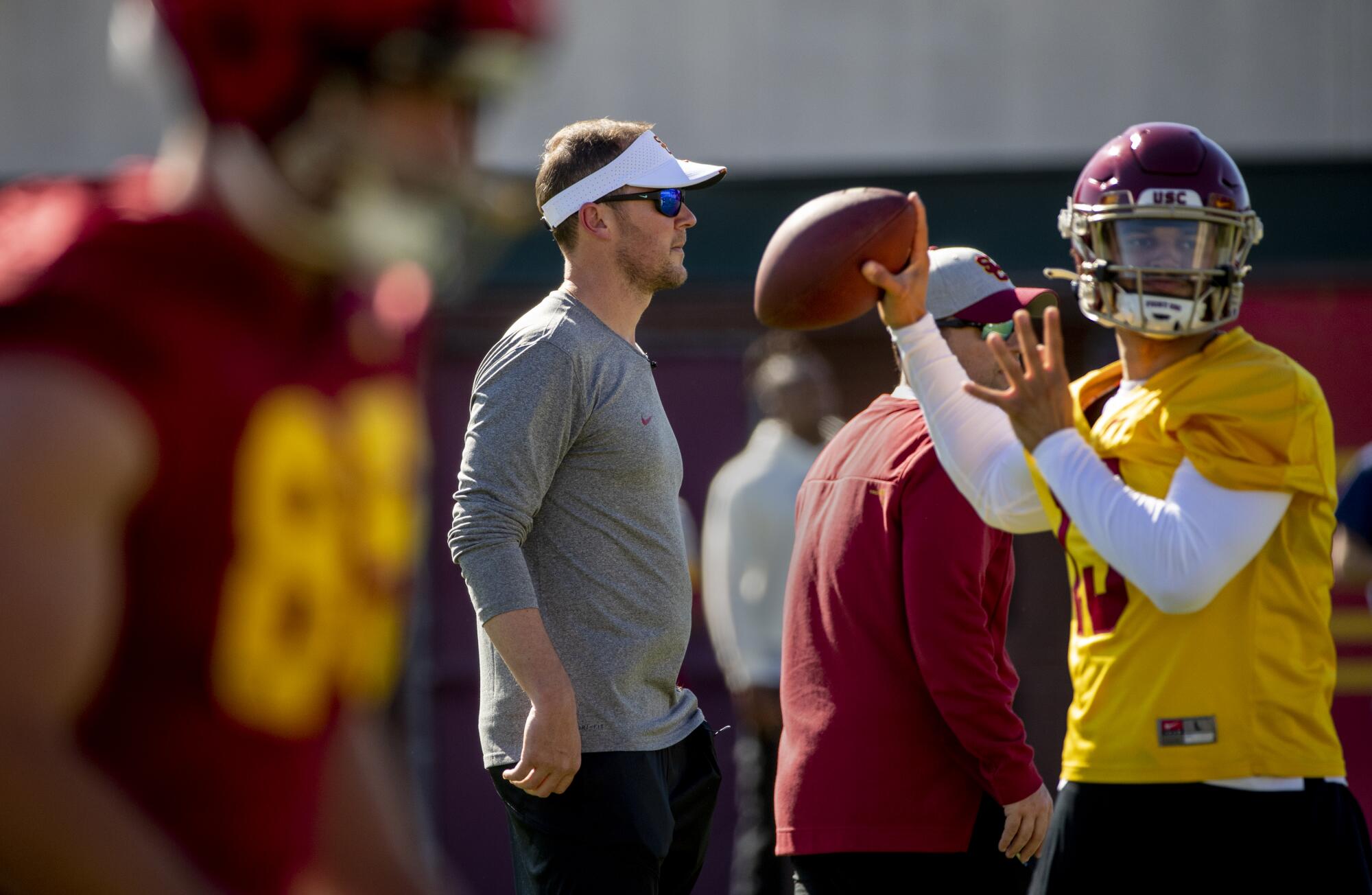
It’s a lesson he learned long ago from Leach, and at USC, Riley will have no shortage of talent to work with again. Williams is a preseason Heisman contender. The Trojans’ top receiver, Jordan Addison, won the Biletnikoff Award in 2021 as the best wideout in college football. Travis Dye, USC’s presumed top back, led the Pac-12 in all-purpose yards last year.
As that new offense gears up for its long-awaited debut, the word “mastermind” has been used liberally around USC’s practice field.
“Every time he opens his mouth, I’m quiet,” Dye said. “Because he’s always planning up something where I’m like, ‘Wow, I wouldn’t even notice that. Wow, this is a mastermind at work.’”
The particulars of that work at USC are largely still a mystery. Though the Trojans ran a version of the Air Raid the past three seasons under Graham Harrell, “this is a totally different, new offense,” says wideout Gary Bryant Jr. In the spring, Riley wouldn’t even commit to the same name for his scheme.
“I don’t know that Air Raid really fits anymore, to be honest,” Riley said in April.
Every USC football player would be paid $50,000 for name, image and likeness under a plan that would bring Trojan Clubs into a Student Body Right collective.
Call it whatever you will, Mumme can still see the same concepts he and Leach helped devise years ago on long car trips across the country. He picks them out in football games at every level these days, still stunned at how those ideas have come this far from Copperas Cove.
Mumme wonders where Riley might take USC’s offense next, what new wrinkle he might add or edge he might try to exploit.
The godfather of the Air Raid is sure of one thing, at least: “They’re gonna be fun to watch,” Mumme said, “I promise you that.”
More to Read
Go beyond the scoreboard
Get the latest on L.A.'s teams in the daily Sports Report newsletter.
You may occasionally receive promotional content from the Los Angeles Times.

